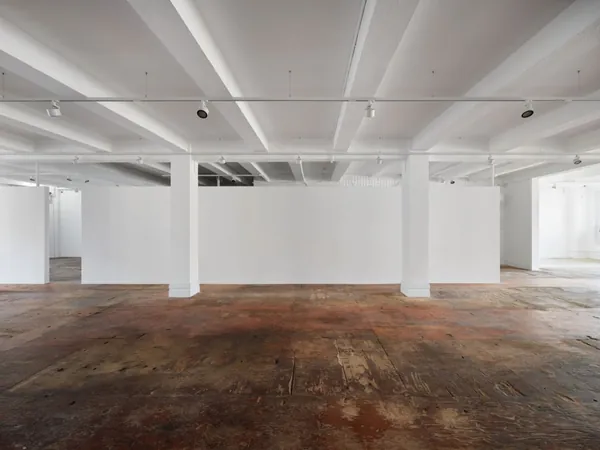
Hong Kong's Kiang Malingue Gallery Sets Sail for New York: A Bold Move to Inspire Art Dialogues
2025-05-09
Author: Ying
In an exciting leap across the Pacific, Kiang Malingue, one of Hong Kong's top art galleries, is set to unveil its new space in New York’s vibrant Chinatown this week. Known for its stellar blend of emerging talent and celebrated Asian artists, this gallery has made waves in the art scene over the past 15 years.
Among its impressive roster are artists like Ellen Pau, who represented Hong Kong at the Venice Biennale in 2001, and Ho Tzu Nyen from Singapore, who showcased in 2011. The gallery also champions incredible talents based in the U.S., such as Homer Shew, Brook Hsu, and Kyung-Me.
Founders Edouard Malingue and Lorraine Kiang describe the move to New York as part of a strategic vision to engage with a burgeoning community of young Asian American collectors, tapping into the growing global interest in Asian and Asian diaspora artists.
Malingue emphasized the need for a dialogue between the East and the West. After years of running the gallery in Hong Kong, we wanted to have a foot in the West to continue promoting our program and create more exchanges with Western audiences, he stated.
Kiang added, The program was always meant to evolve, and opening in New York allows us to see how it can grow in a different context. With the art world increasingly hungry for a deeper understanding of Asian artists, Kiang Malingue aims to fill a gap in the market: There aren’t enough galleries that truly dive into this subject matter, she said.
Nestled at 50 Eldridge Street, the gallery's inaugural exhibition will showcase new works by Japanese artist Hiroka Yamashita, marking her solo debut in New York. It’s a poignant homecoming for Yamashita, who earned her MFA from Rutgers University in 2019 and hasn’t returned since. It’s an exciting return for her—she’s quite familiar with the city, said Kiang.
The trend of Chinese galleries establishing a presence in New York is on the rise, reflecting a broader migration as affluent Chinese are moving to the U.S. This year alone has seen the launch of notable galleries like Alisan Fine Arts and Shanghai’s Bank, which represent some of the continent’s most avant-garde artists.
Kiang Malingue recognizes the opportunity to cultivate community ties with affluent individuals and members of the Asian diaspora. It’s like how Asians seek out Asian cuisine in New York, Kiang noted, expressing excitement in the eagerness of local collectors to engage with art from Hong Kong, Greater China, and Southeast Asia. There’s a familiarity in both the language and the artwork.
Despite these challenges, Malingue believes the gallery should be a hub of discovery for all art lovers. A gallery’s role is to unite people and to create a space where unexpected connections can be made, he mentioned.
In its debut year, Kiang Malingue aims to host three to four exhibitions before refining its strategy for the future. While some programming will link back to Hong Kong, the New York branch will also focus on local connections.
Kiang likened their approach to nurturing two trees: One deeply rooted in Hong Kong, and a young one we’re planting in New York.
Launching during a time of market contraction and heightened geopolitical tensions might seem risky, especially with tariffs affecting Chinese imports, including those from Hong Kong. However, Malingue insists their operations are currently intact, even if challenges loom ahead.
It’s tough, but now is precisely when we need to foster dialogue between New York and Hong Kong, he expressed, highlighting the importance of educating the public about artists’ contributions.
Kiang Malingue has long championed multimedia art, particularly video, which is less impacted by tariffs. Upcoming is a video exhibition by artist Zheng Bo. While committed to diverse mediums, Malingue noted that a residency program for artists might emerge if tariffs become prohibitive.
Despite uncertain US-China relations, Malingue remains optimistic, pointing out that U.S. institutions continue to show keen interest in global art initiatives. American institutions are still very engaged, curious, and supportive, he asserted.
While it may seem counterintuitive to launch a gallery during a downturn, experts argue that such times often cultivate a shift towards appreciating emerging artists. Kiang agrees, indicating that this could be a golden opportunity as collectors’ interests pivot towards experimental and conceptual artists, who typically come with lower price tags.



 Brasil (PT)
Brasil (PT)
 Canada (EN)
Canada (EN)
 Chile (ES)
Chile (ES)
 Česko (CS)
Česko (CS)
 대한민국 (KO)
대한민국 (KO)
 España (ES)
España (ES)
 France (FR)
France (FR)
 Hong Kong (EN)
Hong Kong (EN)
 Italia (IT)
Italia (IT)
 日本 (JA)
日本 (JA)
 Magyarország (HU)
Magyarország (HU)
 Norge (NO)
Norge (NO)
 Polska (PL)
Polska (PL)
 Schweiz (DE)
Schweiz (DE)
 Singapore (EN)
Singapore (EN)
 Sverige (SV)
Sverige (SV)
 Suomi (FI)
Suomi (FI)
 Türkiye (TR)
Türkiye (TR)
 الإمارات العربية المتحدة (AR)
الإمارات العربية المتحدة (AR)